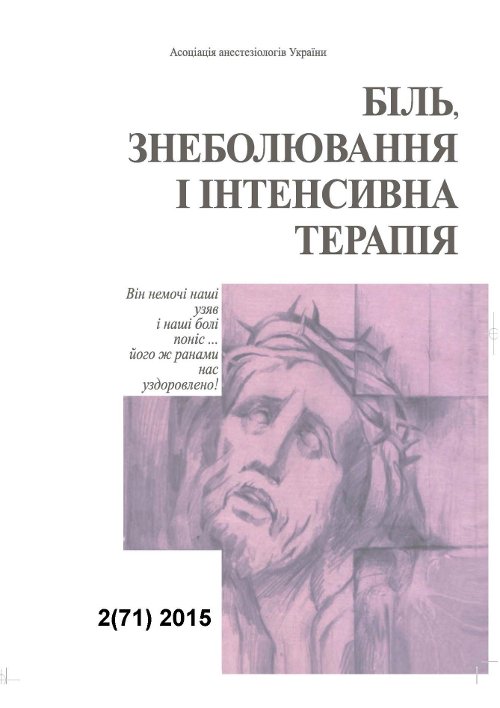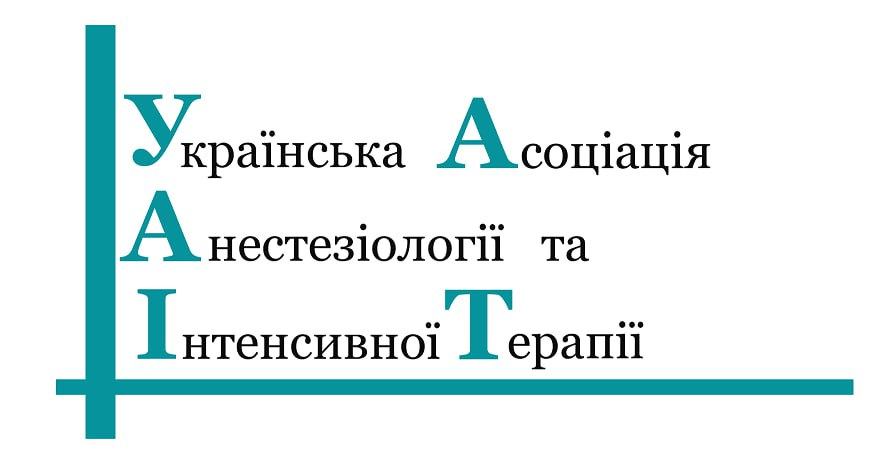Штучна вентиляція легенів при черепно-мозковій травмі
DOI:
https://doi.org/10.25284/2519-2078.2(71).2015.84821Ключові слова:
черепно-мозкова травма, механiчна вентиляцiя легеньАнотація
Представленi данi щодо особливостей проведення механiчної вентиляцiї легень у хворих з черепно-мозковою травмою. Показано, що при черепно-мозковiй травмi, ускладненiй екстрацеребральними порушеннями, зокрема гострим респiраторним синдромом легень, створюються надзвичайно складнi умови для проведення респiраторної пiдтримки та керування механiчною вентиляцiєю. Вториннi гiпоксично-iшемiчнi ушкодження мозку внаслiдок гiпоксемiї/гiпоксiї та гiперкапнiї потребують швидкої корекцiї та стратегії безпечної штучної вентиляцiї легень. Необхiдно дотримуватися принципiв вентиляцiї, спрямованих на запобiгання в олюмотравмi i баротравмi. Усi захиснi стратегiї штучної вентиляцiї легень повиннi суворо виконуватися, особливо у цiєї категорiї хворих. Пiдтримання адекватної оксигенацiї тканин мозку має важливе значення для досягнення успiшного результату. Створення позитивного тиску в кiнцi видиху полiпшує оксигенацiю шляхом залучення i розкриття додаткових альвеол, збiльшення функціональної залишкової ємностi та запобiгає виникненню ателектазiв. Однак це може мати несприятливi неврологiчнi наслiдки в певних клiнiчних обставинах. Наведено данi про роль контролю РаСО2, монiторингу внутрiшньочерепного тиску. при черепно-мозковiй травмi пiд час проведення штучної вентиляцiї легень, нетрадицiйнi стратегiї вентиляцiйної пiдтримки, припинення штучної вентиляцiї легень при гострiй черепно-мозковiй травмi, проведення трахеостомiї, вплив санацiї та аспiрацiї з трахеї i бронхiв на внутрiшньочерепний тиск.Посилання
Rincon F., Ghosh S., Dey S., Maltenfort M., Vibbert M., Urtecho J., McBride W., Moussouttas M., Bell R., Ratliff J.K., Jallo J. Impact of acute lung injury and acute respiratory distress syndrome after traumatic brain injury in the United States. Neurosurgery. 2012 Oct;71(4):795-803. https://doi.org/10.1227/neu.0b013e3182672ae5
Monahan L.J. Acute respiratory distress syndrome. Curr Probl Pediatr Adolesc Health Care. 2013 Nov-Dec; 43(10): 278-84. https://doi.org/10.1016/j.cppeds.2013.10.004
Vrettou C.S., Zakynthinos S.G., Malachias S., Mentzelopoulos S.D. High-frequency oscillation and tracheal gas insufflation in patients with severe acute respiratory distress syndrome and traumatic brain injury: an interventional physiological study. Crit Care. 2013 Jul 11;17(4):R136. https://doi.org/10.1186/cc12815
López-Aguilar J., Fernández-Gonzalo M.S., Turon M., Quílez M.E., Gómez-Simón V., Jódar M.M., Blanch L; GT-IRA de la SEMICYUC. [Lung-brain interaction in the mechanically ventilated patient]. Med Intensiva. 2013 Oct;37(7):485-92. https://doi.org/10.1016/j.medine.2012.10.016
Lee K., Rincon F. Pulmonary complications in patients with severe brain injury. Crit Care Res Pract. 2012;2012:207247. https://doi.org/10.1155/2012/207247
Lou M., Xue F., Chen L., Xue Y., Wang K. Is high PEEP ventilation strategy safe for acute respiratory distress syndrome after severe traumatic brain injury? Brain Inj. 2012;26(6):887-90. https://doi.org/10.3109/02699052.2012.660514
Review. Heuer J.F., Pelosi P., Hermann P., Perske C., Crozier T.A., Brück W., Quintel M. Acute effects of intracranial hypertension and ARDS on pulmonary and neuronal damage: a randomized experimental study in pigs. Intensive Care Med. 2011 Jul;37(7):1182-91. https://doi.org/10.1007/s00134-011-2232-2
Salim A. Martin M., Brown C., Inaba K., Browder T., Rhee P., Teixeira P.G., Demetriades D. The presence of the adult respiratory distress syndrome does not worsen mortality or discharge disability in blunt trauma patients with severe traumatic brain injury. Injury. 2008 Jan;39(1):30-5. https://doi.org/10.1016/j.injury.2007.06.015
Царенко С.В., Нейрореаниматология. Интенсивная терапия черепно-мозговой травмы. - 2-е изд. - М.: ОАО «Издателство «Медицина», 2006. - 352 с.
Pelosi P., Sutherasan Y. High-frequency oscillatory ventilation with tracheal gas insufflation: the rescue strategy for brain-lung interaction. Crit Care. 2013 Aug 27; 17 (4) : R179. https://doi.org/10.1186/cc12862
Keszler M., Abubakar K.M. Volume guarantee ventilation. Clin Perinatol. 2007 Mar;34(1):107-116.e4. https://doi.org/10.1016/j.clp.2006.12.011
Pelosi P., Severgnini P. and Chiaranda M. An integrated approach to prevent and treat respiratory failure in brain-injured patients. Current Opinion in Critical Care. 2005; 11: 37-42. https://doi.org/10.1097/00075198-200502000-00006
Ventilation with lower tidal volumes as compared with traditional tidal volumes for acute lung injury and acute respiratory distress syndrome. The Acute Respiratory Distress Syndrome Network. New England Journal of Medicine. 2000; 342 (18): 1301-8. https://doi.org/10.1056/nejm200005043421801
Stevens R.D., Lazaridis C. and Chalela J.A. The role of mechanical ventilation in acute brain injury. Neurologic Clinics. 2008; 26:543-563. https://doi.org/10.1016/j.ncl.2008.03.014
Pelosi P., Barassi A., Severgnini P., Gomiero B., Finazzi S., Merlini G., d’Eril G.M., Chiaranda M., Niederman M.S. Prognostic role of clinical and laboratory criteria to identify early ventilator-associated pneumonia in brain injury. Chest. 2008 Jul;134(1):101-8.Epub 2008 Apr 10. https://doi.org/10.1378/chest.07-2546
Hui X., Haider A.H., Hashmi Z.G., Rushing A.P., Dhiman N., Scott V.K., Selvarajah S., Haut E.R., Efron D.T., Schneider E.B. Increased risk of pneumonia among ventilated patients with traumatic brain injury: every day counts! J Surg Res. 2013 Sep; 184(1): 438-43. https://doi.org/10.1016/j.jss.2013.05.072
Kahl J.E., Calvo R.Y., Sise M.J., Sise C.B., Thorndike J.F., Shackford S.R. The changing nature of death on the trauma service. J Trauma Acute Care Surg. 2013 Aug; 75(2):195-201. https://doi.org/10.1097/ta.0b013e3182997865
Mascia L. Acute lung injury in patients with severe brain injury: A double hit model. Neurocritical Care. 2009; 11:417-426. https://doi.org/10.1007/s12028-009-9242-8
Colice G.L., Matthay M.A., Bass E., Matthay R.A. Neurogenic pulmonary edema. Am Rev Respir Dis. 1984 Nov;130 (5):941-8. https://doi.org/10.1164/arrd.1984.130.5.941
Pyeron A.M. Respiratory failure in the neurological patient: the diagnosis of neurogenic pulmonary edema. J Neurosci Nurs. 2001 Aug;33(4):203-7. https://doi.org/10.1097/01376517-200108000-00006
Bell M.J., Kochanek P.M., Doughty L.A., Carcillo J.A., Adelson P., Clark R.S., Wisniewski S.R., Whalen M.J., DeKosky S.T. Interleukin-6 and interleukin-10 in cerebrospinal fluid after severe traumatic brain injury in children. J Neurotrauma. 1997 Jul;14(7):451-7. https://doi.org/10.1089/neu.1997.14.451
Knoblach S.M., Faden A.I. Interleukin-10 improves outcome and alters proinflammatory cytokine expression after experimental traumatic brain injury. Exp Neurol. 1998 Sep;153(1):143-51. https://doi.org/10.1006/exnr.1998.6877
Youn Y., Sung I.K., Lee I.G. The role of cytokines in seizures: interleukin (IL)-1β, IL-1Ra, IL-8, and IL-10. Korean J. Pediatr. 2013 Jul;56(7):271-4. Epub 2013 Jul 19. https://doi.org/10.3345/kjp.2013.56.7.271
Chang W.T., Nyquist P.A. Strategies for the use of mechanical ventilation in the neurologic intensive care unit. Neurosurg Clin N Am. 2013 Jul;24(3):407-16. Epub 2013 Mar 29. https://doi.org/10.1016/j.nec.2013.02.004
Wijayatilake D.S., Shepherd S.J., Sherren P.B. Updates in the management of intracranial pressure in traumatic brain injury. Curr Opin Anaesthesiol. 2012 Oct;25(5):540-7. https://doi.org/10.1097/aco.0b013e328357960a
Nyquist P., Stevens R.D. and Mirski M.A. Neurologic injury and mechanical ventilation. Neurocritical Care. 2008; 9:400-408. https://doi.org/10.1007/s12028-008-9130-7
Bratton S.L., Chestnut R.M., Ghajar J., et al. Hyperventilation. Journal of Neurotrauma. 2007; 24 Suppl 1:S87-S90. https://doi.org/10.1089/neu.2007.9982
Lapinsky S.E., Posadas-Colleja J.G. and McCullagh I. Clinical review: ventilatory strategies for obstetric, brain-injured and obese patients. Critical Care. 2009; 13(2):206. https://doi.org/10.1186/cc7146
Lowe G.L., Ferguson N.D. Lung-protective ventilation in neurosurgical patients. Curr Opin Crit Care. 2006;12:3–7. https://doi.org/10.1097/01.ccx.0000198055.29600.4b
Bratton S.L., Davis R.L. Acute lung injury in isolated traumatic brain injury. Neurosurgery. 1997; 40:707-712. https://doi.org/10.1097/00006123-199704000-00009
Holland M.C., Mackersie R.C., Morabito D., Campbell A.R., Kivett V.A., Patel R., Erickson V.R., Pittet J.F. The development of acute lung injury is associated with worse neurologic outcome in patients with severe traumatic brain injury. J Trauma. 2003;55:106–111. https://doi.org/10.1097/01.ta.0000071620.27375.be
Mascia L., Zavala E., Bosma K., Pasero D., Decaroli D., Andrews P., Isnardi D., Davi A., Arguis M.J., Berardino M., Ducati A., Brain I.T. Group High tidal volume is associated with the development of acute lung injury after severe brain injury: an international observational study. Crit Care Med. 2007; 35:1815–1820. https://doi.org/10.1097/01.ccm.0000275269.77467.df
Nelson N., Janerot-Sjöberg B. Beat-to-beat changes in stroke volume precede the general circulatory effects of mechanical ventilation: a case report. Crit Care. 2001; 5(1): 41–45. https://doi.org/10.1186/cc977
Huynh T., Messer M., Sing R.F., Miles W., Jacobs D.G. and Thomason M.H. Positive end-expiratory pressure alters intracranial and cerebral perfusion pressure in severe traumatic brain injury. Journal of Trauma. 2002; 53 (3):488-493. https://doi.org/10.1097/00005373-200209000-00016
Pulitanò S., Mancino A., Pietrini D., Piastra M., De Rosa S., Tosi F., De Luca D., Conti G. Effects of positive end expiratory pressure (PEEP) on intracranial and cerebral perfusion pressure in pediatric neurosurgical patients. J Neurosurg Anesthesiol. 2013 Jul;25(3):330-4. https://doi.org/10.1097/ana.0b013e31828bac4d
Schramm P., Closhen D., Felkel M., Berres M., Klein K.U., David M., Werner C., Engelhard K. Influence of PEEP on cerebral blood flow and cerebrovascular autoregulation in patients with acute respiratory distress syndrome. J Neurosurg Anesthesiol. 2013 Apr;25(2):162-7. https://doi.org/10.1097/ana.0b013e31827c2f46
Lou M., Xue F., Chen L., Xue Y., Wang K. Is high PEEP ventilation strategy safe for acute respiratory distress syndrome after severe traumatic brain injury? Brain Inj. 2012;26(6):887-90. Review. https://doi.org/10.3109/02699052.2012.660514
Davis D. P. Early ventilation in traumatic brain injury. Resuscitation. 2008; 76: 333-340. https://doi.org/10.1016/j.resuscitation.2007.08.004
Gelb A.W. and Chan M.T.V. Hyperventilation — an ill wind that sometimes blows good. Canadian Journal of Anaesthesia. 2008; 55(11):735-8. https://doi.org/10.1007/bf03016345
Warner K.J., Cuschieri J., Copass M.K., Jurkovich G.J. and Bulger E.M. Emergency department ventilation effects outcome in severe traumatic brain injury. Journal of Trauma. 2008; 64(2):341-7. https://doi.org/10.1097/ta.0b013e318160dfb3
Lee S.W., Hong Y.S., Han C., et al. Concordance of end-tidal carbon dioxide and arterial carbon dioxide in severe traumatic brain injury. Journal of Trauma. 2009; 67(3): 526-530. https://doi.org/10.1097/ta.0b013e3181866432
Curley G., Kavanagh B.P., Laffey J.G. Hypocapnia and the injured brain: more harm than benefit. Crit Care Med. 2010 May;38(5):1348-59. https://doi.org/10.1097/ccm.0b013e3181d8cf2b
Review. Czosnyka M., Brady K., Reinhard M., Smielewski P., Steiner L.A. Monitoring of cerebrovascular autoregulation: facts, myths, and missing links. Neurocrit Care. 2009;10(3):373-86. https://doi.org/10.1007/s12028-008-9175-7
Gianino J.W., Afuwape L.O. Evidence-based guidelines for the management of traumatic brain injury. Mo Med. 2012 Sep-Oct;109 (5): 384-7.
Malakouti A., Sookplung P., Siriussawakul A., Philip S., Bailey N., Brown M., Farver K., Zimmerman J.J., Bell M.J., Vavilala M.S. Nutrition support and deficiencies in children with severe traumatic brain injury. Pediatr Crit Care Med. 2012 Jan; 13 (1): e18-24. https://doi.org/10.1097/pcc.0b013e31820aba1f
Sheth K.N., Stein D.M., Aarabi B., Hu P., Kufera J.A., Scalea T.M., Hanley D.F. Intracranial pressure dose and outcome in traumatic brain injury. Neurocrit Care. 2013 Feb;18(1):26-32. https://doi.org/10.1007/s12028-012-9780-3
Krbila S., Waczulikova I., Sobona V., Zahorec R. Impact of intracranial pressure measurement on survival in patients with severe traumatic brain injury. Bratisl Lek Listy. 2013; 114(12):696-701. https://doi.org/10.4149/bll_2013_147
Pelosi P., Brazzi L. and Gattinoni L. Prone position in acute respiratory distress syndrome. European Respiratory Journal. 2002; 20(4):1017-1028. https://doi.org/10.1183/09031936.02.00401702
Gattinoni L., Tognoni G., Pesenti A., et al. Effect of prone positioning on the survival of patients with acute respiratory failure. New England Journal of Medicine. 2001; 345(8):568-573. https://doi.org/10.1056/nejmoa010043
Reinprecht A., Greher M., Wolfsberger S., et al. Prone position in subarachnoid hemorrhage patients with acute respiratory distress syndrome: Effects on cerebral tissue oxygenation and intracranial pressure. Critical Care Medicine. 2003; 31(6): 1831-8. https://doi.org/10.1097/01.ccm.0000063453.93855.0a
Thelandersson A., Cider A., Nellgеrd B. Prone position in mechanically ventilated patients with reduced intracranial compliance. Acta Anaesthesiol Scand. 2006 Sep;50(8):937-41. https://doi.org/10.1111/j.1399-6576.2006.01037.x
Сатишур О.Е. Механическа я вентиляция легких. М.: Мед. Лит., 2007. - 352 с.
Lo T.M., Jones P.A., Freeman J.A., McFazcan and Minns R.A. The role of high frequency oscillatory ventilation in the management of children with severe traumatic brain injury and concomitant lung pathology. Paediatric Critical Care Medicine. 2008; 9(5): e38-e42. https://doi.org/10.1097/pcc.0b013e3181731ab7
Salim A., Miller K., Dangleben D., Cipolle M. and Pasquale M. High-frequency percussive ventilation: an alternative mode of ventilation for head-injured patients with adult respiratory distress syndrome. Journal of Trauma. 2004; 57: 542-6. https://doi.org/10.1097/01.ta.0000135159.94744.5f
Pittet, J. F., Forster, P. M., Suter A. High frequency jet ventilation and intermittent positive pressure ventilation. Effect of cerebral blood flow in patients after open heart surgery. Chest, 1990, 97: 420 – 424. https://doi.org/10.1378/chest.97.2.420
Lanzenberger-Schragl E., Donner A., Kashanipour A. et al. High frequency ventilation techniques in ARDS. Acta Anaesth. Scand., 1996; 109:157-61.
Burguillo P., Rodriguez M.C., Rubio J.J. et al. Effects of high-frequency ventilation on the intracranial pressure and cerebral elastance in dogs. Anales Espanoles de Pediatria. 1989; 30(6): 463-467.
Hurst, J. M., Saul, C., De Haven et al. Use of high frequency jet ventilation during mechanical hyperventilation to reduce intracranial pressure in patients with multiple organ system injury. Neurosurgery, 1984; 15: 530–534. https://doi.org/10.1227/00006123-198410000-00010
Молчанов, И. В. Принципы интенсивной терапии изолированной черепно-мозговой травмы. Анестезиология и реаниматология. 2002, No 3, С.12 – 17.
Белкин А.А., Зислин Б.Д.,.Инюшкин С.Н. и соавт. / Цереброваскулярные эффекты искусственной вентиляции легких у больных с острой церебральной недостаточностью при наличии внутричерепной гипертензии. Анестезиология и реаниматология, 2005, No3, С.33-35.
Menut R., Larrieu N., Conil J.M., Georges B., Fourcade O., Geeraerts T. [Use of ECMO (extracorporeal membrane oxygenation) in a traumatic brain injured patient with severe hypoxemia]. Ann Fr Anesth Reanim. 2013; 32(10):701-3. https://doi.org/10.1016/j.annfar.2013.04.014
Bein T., Scherer M.N., Philipp A., Weber F. and Woertgen C. Pumpless extracorporeal lung assist in patients with acute respiratory distress syndrome and severe brain injury. J Trauma. 2005; 58(6):1294-97. https://doi.org/10.1097/01.ta.0000173275.06947.5c
Raets M.M., Dudink J., Ijsselstijn H., van Heijst A.F., Lequin M.H., Houmes R.J., Wildschut E.D., Reiss I.K., Govaert P., Tibboel D. Brain injury associated with neonatal extracorporeal membrane oxygenation in the Netherlands: a nationwide evaluation spanning two decades. Pediatr Crit Care Med. 2013; 14(9):884-92. https://doi.org/10.1097/pcc.0b013e3182a555ac
dos Reis H.F., Almeida M.L., da Silva M.F., Rocha Mde S. Extubation failure influences clinical and functional outcomes in patients with traumatic brain injury. J Bras Pneumol. 2013;39(3):330-8. https://doi.org/10.1590/s1806-37132013000300010
Roquilly A., Cinotti R., Jaber S., Vourc’h M., Pengam F., Mahe P.J., Lakhal K., Demeure Dit Latte D., Rondeau N., Loutrel O., Paulus J., Rozec B., Blanloeil Y., Vibet M.A., Sebille V., Feuillet F., Asehnoune K. Implementation of an Evidence-based Extubation Readiness Bundle in 499 Brain-injured Patients. A Before–After Evaluation of a Quality Improvement Project. Am J Respir Crit Care Med. 2013 Oct 15;188 (8): 958-66. https://doi.org/10.1164/rccm.201301-0116oc
O’Connor H., Al-Qadheeb N.S., White A.C., Thaker V., Devlin J.W. Agitation During Prolonged Mechanical Ventilation at a Long-Term Acute Care Hospital: Risk Factors, Treatments, and Outcomes. J Intensive Care Med. 2013 Apr 29. https://doi.org/10.1177/0885066613486738
Scales D.C., Thiruchelvam D., Kiss A. and Redelmeier D.A. The effect of tracheostomy timing during critical illness on long-term survival. Criti cal Care Medicine. 2008; 36(9):2547-2557. https://doi.org/10.1097/ccm.0b013e31818444a5
Walcott B.P., Kamel H., Castro B., Kimberly W.T., Sheth K.N. Tracheostomy after Severe Ischemic Stroke: A Population-based Study. J Stroke Cerebrovasc Dis. 2013 Oct 5. pii: S1052-3057(13)00348-0. https://doi.org/10.1016/j.jstrokecerebrovasdis.2013.08.019
Goettler C.E., Fugo J.R., Bard M.R., Newell M.A., Sagraves S.G., Toschlog E.A., Schenarts P.J., Rotondo M.F. Predicting the need for early tracheostomy: a multifactorial analysis of 992 intubated trauma patients. J Trauma. 2006 May;60 (5): 991-6. https://doi.org/10.1097/01.ta.0000217270.16860.32
Huang Y.H., Lee T.C., Liao C.C., Deng Y.H., Kwan A.L. Tracheostomy in craniectomised survivors after traumatic brain injury: a cross-sectional analytical study. Injury. 2013 Sep; 44(9): 1226-31. https://doi.org/10.1016/j.injury.2012.12.029
Seguen V., Le Strat O., Mornet E., Coignard P., Le Coz A., Seizeur R. [Care of the tracheostomy in brain injury patients]. Soins. 2012 Mar;(763):44-6. https://doi.org/10.1016/j.soin.2012.03.006
Combes A. Luyt C.E., Nieszkowska A., Trouillet J.L., Gibert C. and Chastre J. Is tracheostomy associated with better outcomes for patients requiring long-term mechanical ventilation? Critical Care Medicine. 2007; 35(3): 802-7. https://doi.org/10.1097/01.ccm.0000256721.60517.b1
Clec’h C., Alberti C., Vincent F., et al. Tracheostomy does not improve the outcome of patients requiring prolonged mechanical ventilation: A propensity analysis. Critical Care Medicine. 2007; 35(1):132-8. https://doi.org/10.1097/01.ccm.0000251134.96055.a6
Murillo A., Castellano V., Torrente S., Cornejo C., Vinagre R., Cuenca M. [Endotrachael aspiration protocol in patients with serious cranial trauma. study of neurophysiological variables]. Enferm Intensiva. 2002 Jul-Sep;13(3):99-106. https://doi.org/10.1016/s1130-2399(02)78070-x
Chivite Fernández N., Martínez Oroz A., Marraco Bonmcompte M., Navarro García M.A., Nuin E.S., Gómez de Segura Nieva J.L., Bermejo Fraile B. [Intracranial pressure response during secretion aspiration after administration of a muscle relaxant]. En ferm Intensiva. 2005 Oct-Dec ;16(4):143-52. https://doi.org/10.1016/s1130-2399(05)73401-5
##submission.downloads##
Опубліковано
Як цитувати
Номер
Розділ
Ліцензія
Авторське право (c) 2015 В. І. Снiсарь, О. Р. Лацинський

Ця робота ліцензується відповідно до Creative Commons Attribution-NonCommercial 4.0 International License.
Автори, які публікуються у цьому журналі, погоджуються з наступними умовами:
a. Автори залишають за собою право на авторство своєї роботи та передають журналу право першої публікації цієї роботи на умовах ліцензії Creative Commons Attribution-NonCommercial 4.0 International License, котра дозволяє іншим особам вільно розповсюджувати опубліковану роботу з обов'язковим посиланням на авторів оригінальної роботи та першу публікацію роботи у цьому журналі.
b. Автори мають право укладати самостійні додаткові угоди щодо неексклюзивного розповсюдження роботи у тому вигляді, в якому вона була опублікована цим журналом (наприклад, розміщувати роботу в електронному сховищі установи або публікувати у складі монографії), за умови збереження посилання на першу публікацію роботи у цьому журналі.
c. Політика журналу дозволяє і заохочує розміщення авторами в мережі Інтернет (наприклад, у сховищах установ або на особистих веб-сайтах) рукопису роботи, як до подання цього рукопису до редакції, так і під час його редакційного опрацювання, оскільки це сприяє виникненню продуктивної наукової дискусії та позитивно позначається на оперативності та динаміці цитування опублікованої роботи (див. The Effect of Open Access).








